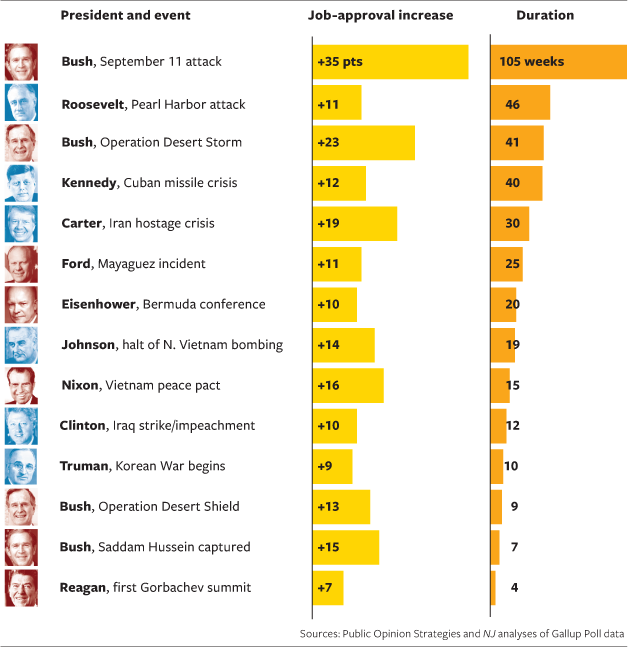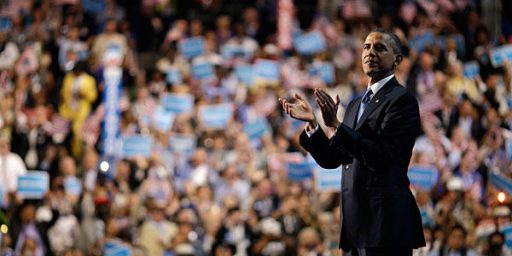Why Obama’s Osama Bounce Didn’t Last
President Obama's approval numbers shot up after Osama bin Laden was killed two weeks ago. They've already settled back to where they were
President Obama’s approval numbers shot up after Osama bin Laden was killed two weeks ago. They’ve already settled back to where they were, Hotline reports:
Obama’s approval rating is now at 46 percent, equal to his approval rating in the last tracking poll conducted before Obama addressed Americans late on May 1 and informed them of bin Laden’s death. Forty-four percent of Americans now disapprove of the job Obama is doing as president.
According to the Gallup poll, Obama’s approval rating crested at 52 percent after the bin Laden killing. His disapproval rating never fell lower than 40 percent.
Obama’s bounce is smaller in magnitude and shorter in duration than the bumps enjoyed by other presidents over the past 70 years, according to a study by Republican polling firm Public Opinion Strategies. For example, George W. Bush received a 15-point bump after the capture of Saddam Hussein in 2003 — a bounce that lasted seven weeks.
The graphic National Journal produced on that is interesting:
It’s somewhat misleading, however. The 9/11 bump was, of course, massive. Not only was it a nationally catalyzing event but Bush’s numbers were fairly low before it, owing to the hangover from the bitter post-election fight over Florida, making the bounce bigger. But the bounce wasn’t sustained by 9/11 alone but by the national frenzy that followed it, including two wars and other major policy reactions that kept it in the news. The wars, especially Iraq, eventually made Bush quite unpopular. But there was an enormous rally effect in the early days and the initial success in both places was awe-inspiring.
Contrast that with the bin Laden raid. It was spectacular and, one hopes, a less ephemeral success. One presumes, too, that it will permanently put to rest doubts about Obama’s ability to make tough decisions about the use of military power–something that will doubtless help with swing voters who tend to vote Republican in a tie because of national defense.
But, unlike 9/11 or Pearl Harbor, the narrative wasn’t changed. National security hasn’t become the main story as it did with the World War II, Vietnam, the Iran Hostage Crisis, or the Global War on Terror. The economy remains and is likely to remain the main act.






Were Operation Desert Storm, the Cuban missile crisis, and the Iran hostage crisis “national catalyzing” events? Maybe so but certainly not in the way that either 9/11 or the attack on Pearl Harbor were. In addition, unlike the two top events and the killing of Osama bin Laden, they went on for some period of time.
How do you compare a singular punctuated event to an incident that unfolds over weeks or months? I think there’s something wrong with the analysis.
Dave: Yes, that’s my point exactly. Pearl Harbor launched America into WWII, which made the Great Depression a side story. Ditto 9/11. The OBL raid was a one week feel good story but, at the end of the day, the horrible economy remains the focus.
And, of course, it is only one polling outfit. According to Rasmussen, for example, there was hardly any bounce at all. Meanwhile, the less-frequent media sponsored polls showed a large bumb, and one of them, Politico, came out just a few days ago showing a sustained bumb – a +8 approval.
The RealClear net approval average is still about 8-10 points higher than it was before the event.
Wow,, two “bumbs” in a row, thats interesting. I did mean “bump”…
@Tano: Yes, was going to cite the RCP trend graph but didn’t because it’s latent. The methodology is to average the most recent of each of the major polls, so there’s a significant lag factor since there are only two very recent polls in the sample.
It’s the economy, stupid [/Clinton]
Well, that and the continuing dsaproval of Obamacare, etc.
“One presumes, too, that it will permanently put to rest doubts about Obama’s ability to make tough decisions about the use of military power.”
Outside of his 27% hard-core base, it’s doubtful anyone would mistake this unqualified ditherer for a decisive leader. Without the manipulated AP/IPSOS poll that vastly overweighted democrats, his miniscule bounce would hardly have registered.
As the National Journal information shows, poll “bounces” for specific occurrences bear no correlation to reelection chances. When the time comes to vote, Americans think about their job situation, what it costs to fill their gas tank and their general feeling of if the country is on the right track or wrong track.
Obama is toast.
As of today, Gallup tracking is at net +5. Before the OBL: killing, it was slightly negative. So even Gallup, the focus of the Hotline piece, is NOT really showing an end to the bounce.
Jwest beat me to many points. I would even go future with some of this pollster oversampling Democrats in hope to create a pop-star reaction. They were hoping that people would hear his rating was skyrocketing so they would jump on board therefore fulfilling their polls. It didn’t happen so they had to bring it back down to reality.
The reality of it was that he would get a small bump but it would be short lived and come back down.
One thing that cracks me up is how many especially the MSM describes poll data. When Obama gets a 4 to 6 point increase it is a large bump but when it goes back down 4 to 6 it a small decrease. That and when it goes up even a little you see it all over the place but when it goes down you basically only see it reported on Drudge.
Wayne,
These people don’t read Drudge, so they only see the increases.
According to their calculations, Obama should be at about 487% approval now.
You sir, are either a liar or completely delusional.
The exact opposite is the case, as I have had to point out many many times here. Go look through the archives if you have any doubts – there are at least 10 posts about “Obama’s new lows” for every post about an increase. The same is the case in the MSM at large – they always highlight the decreases – it is only when there is a dramatic movement, like now, that the increases make news.
One can be understanding a bit, in that the media has a bottom line – to get viewers / readers. To do so, they need to hype things. “Obama approval goes up 3 points” is not going to make any buzz. “Obama goes down three points” wont either. But “Obama hits historic low” will get some notice. If there are a dozen polling firms, that is a dozen opportunities for such a headline. If his approval then goes up 2 pts, thats a non story,. If it then goes down three points, you have a new opportunity for new “historic low” stories.
Since he started out with a honeymoon, numbers up around 70 or so, the mirror process isn’t really available for “historic highs”. Not unless there were some really dramatic event that got him new highs up in the 80s or so – Bush after 9/11 type events.
But somehow I suspect you know all this, and are just spewing dishonest crap because thats what you guys on the right seem to do for a living.